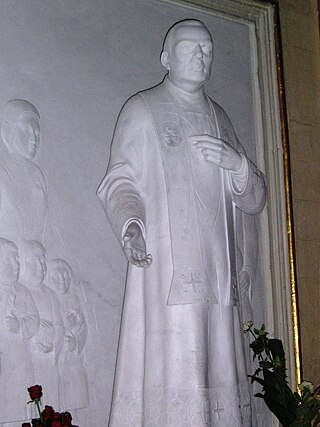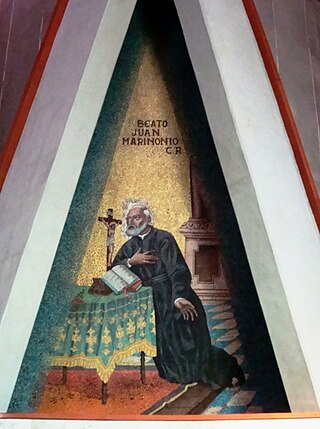
Henry was a medieval English clergyman. He came to Sweden with Cardinal Nicholas Breakspeare in 1153 and was most likely designated to be the new Archbishop of Uppsala, but the independent church province of Sweden could only be established in 1164 after the civil war, and Henry would have been sent to organize the Church in Finland, where Christians had already existed for two centuries.

Wincenty Kadłubek was a Polish Catholic prelate and professed Cistercian who served as the Bishop of Kraków from 1208 until his resignation in 1218. His episcopal mission was to reform the diocesan priests to ensure their holiness and invigorate the faithful and cultivate greater participation in ecclesial affairs on their part. Wincenty was much more than just a bishop; he was a leading scholar in Poland from the twelfth and thirteenth centuries. He was also a lawyer, historian, church reformer, monk, magister, and the father of Polish culture and national identity.

Turku Cathedral is the only medieval basilica in Finland and the Mother Church of the Evangelical Lutheran Church of Finland. It is the central church of the Lutheran Archdiocese of Turku and the seat of the Lutheran Archbishop of Finland, Tapio Luoma. It is also regarded as one of the major records of Finnish architectural history.

The Catholic Church in Finland is part of the worldwide Catholic Church, under the spiritual leadership of the Pope in Rome.

Giovanni Antonio Farina was an Italian Catholic bishop known for his compassionate treatment of the poor and for his enlightened views of education; he was sometimes dubbed as the "Bishop of the Poor". He served as the Bishop of Vicenza and later as the Bishop of Treviso; he is also known for ordaining the future Pope Pius X to the priesthood.

Filippo Smaldone was an Italian Roman Catholic priest and the founder of the Salesian Sisters of the Sacred Hearts. Smaldone is best known for his extensive work with the deaf during his lifetime. Smaldone was a gifted preacher known for his commitment to proper catechesis and to the care of orphans and the mute, which earned him civic recognition.
The Diocese of Åbo was the medieval, pre-Reformation Catholic predecessor of the later Archdiocese of Turku, a Evangelical Lutheran Church of Finland jurisdiction.
Francesco Spoto was an Italian Catholic priest who served in the missions in the Democratic Republic of Congo and was killed there. He was also a professed member from the Missionary Servants of the Poor.

Pierre de Luxembourg was a French Catholic prelate who served as the Bishop of Metz. He is venerated in the Catholic Church as a blessed, having been beatified by Pope Clement VII, 140 years after his death.

Augustin Kažotić was a Croatian prelate of the Catholic Church and professed member from the Order of Preachers who served as the Bishop of Lucera from 1322 until his death. Kažotić was a humanist and orator who had served first as the Bishop of Zagreb from 1303 until 1322. Kažotić studied in Paris before returning to his homeland where he began working in the missions and preaching in modern Bosnia and Herzegovina. He was one of the first humanist figures to appear in southern Croatia.

Saint Joseph Gabrielof the Rosary, also referred to as Priest Brochero, was a Catholic priest who suffered leprosy throughout his life. He is known for his extensive work with the poor and the sick. He became affectionately known as "the Gaucho priest" and the "cowboy priest".

Blessed Mattia de Nazarei was an Italian Roman Catholic nun of the Poor Clares.

Francesco Marinoni was an Italian Roman Catholic priest who was a member of the Theatines. He assumed the name Giovanni upon his admittance into the order. His cult was confirmed and acted as his formal beatification in 1764 under Pope Clement XIII. His life of heroic virtue was approved and Pope Benedict XVI added the title of Venerable to him despite the fact he was beatified. A miracle - now under investigation - is needed for his canonization.

Andrea Franchi was an Italian Roman Catholic member of the Order of Preachers who served as the Bishop of Pistoia before his resignation due to ill health. Franchi became a noted preacher and evangelist who was also known for his holiness and his deep commitment to the poor of his diocese.
Giacomo Benefatti was an Italian Catholic priest and professed member of the Order of Preachers who ascended to the position of Bishop of Mantua. Benefatti became noted for his tender care of the ill during epidemics of plague and both Pope Benedict XI - a close personal friend - and Pope John XXII held him in high esteem.
Blessed Hartmann of Brixen was a German prelate of the Catholic Church, who served as the Bishop of Brixen from his appointment in 1140 until his death. Hartmann served alongside the Order of Saint Augustine - who oversaw his education - and he managed certain aspects of their order despite not being part of that congregation. He also supported Pope Alexander III during his struggle with Frederick Barbarossa and also earned the favor of the latter despite Hartmann's views of the schism.

The Martyrs of Natal were a group of 30 Roman Catholic people of Colonial Brazil – two of them priests – killed in the northern part of the colony in massacres that a large group of Dutch Calvinists led. One priest was a Colonial Brazilian Jesuit missionary, while the other priest was an evangelizer himself. The others were all lay Catholics, most of them anonymous members of the Church, some of them children.

Brynolf Algotsson was a Swedish Catholic prelate and theologian who served as the Bishop of Skara from 1278 until his death. He was descended from nobles and studied for almost two decades in Paris at the college there before returning to his homeland as a dean and canon prior to his episcopal nomination. He was diligent in his work in reforming the education of schools and the overall reorganization of his episcopal see. He was forced into a brief exile but was able to continue his work upon his return.















